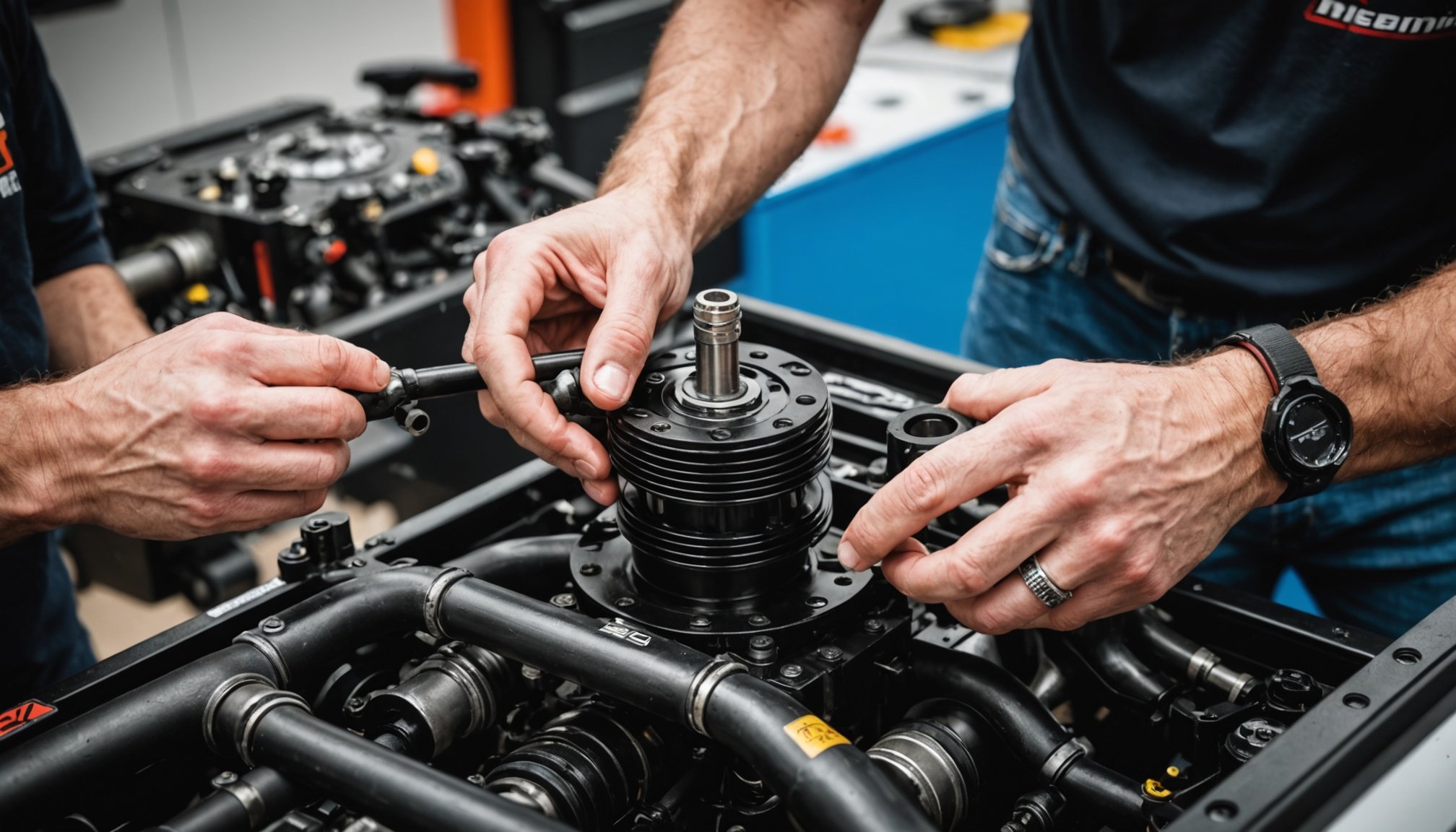Overview of Steering Dampeners
Steering dampeners are essential components in the realm of vehicle handling and high-speed performance. Their primary function is to control and stabilise the steering inputs in vehicles, particularly when navigating uneven surfaces or during high-speed manoeuvres. By absorbing and damping unwanted vibrations, steering dampeners prevent erratic wheel movements, offering a more controlled and seamless driving experience.
The benefits of steering dampeners are notably pronounced when considering high-speed handling scenarios. On UK tracks, where variable conditions can pose challenges, these components are pivotal in reducing the jitter and instability that typically arise at elevated speeds. By ensuring a steady and smooth steering response, drivers can maintain optimal control, enhancing both safety and performance.
Also to read : Transform your ride: a comprehensive guide to upgrading your exhaust system for superior performance and uk regulations compliance
Without a steering dampener, vehicles may experience front-end wobble or handle unpredictably, which is hazardous in high-speed situations. The role of steering dampeners extends beyond mere comfort; they protect against potential accidents by maintaining vehicle stability. Crucially, for UK track enthusiasts who regularly face swift turns and diverse environments, steering dampeners emerge as indispensable, bridging the gap between speed and secure vehicle operation.
How Steering Dampeners Improve Handling
Understanding the role of steering dampeners is key to appreciating their impact on improving vehicle handling. These components significantly enhance steering response and control. By stabilising the steering mechanism, they provide a more predictable and precise driving experience, making it easier to navigate both urban roads and challenging terrains.
Steering dampeners are essential in reducing unwanted steering jitter and vibrations. This reduction is particularly beneficial when driving over uneven surfaces, as it minimises the fatigue encountered during long drives. Furthermore, they assist in maintaining a smoother ride by offering consistent steering control, especially at higher speeds or during sudden manoeuvres.
The relationship between steering dampeners and suspension performance is integral to overall vehicle dynamics. By absorbing shocks and limiting excessive movement, these dampeners contribute to a more balanced suspension system. This effective distribution of force supports better handling and stability, reducing the stress on other suspension components.
Ultimately, steering dampeners not only improve driver comfort but also maximise the performance of the vehicle’s steering and suspension systems. By ensuring a smoother ride with greater control, they play a crucial part in achieving superior vehicle handling. With these enhancements, drivers can enjoy a more engaging and safer driving experience.
Step-by-Step Installation Guide
When it comes to engaging in DIY installation for a steering dampener, proper preparation and planning are key to successful automotive maintenance.
Tools and Materials Required
Before beginning, gather all essential tools and materials to ensure smooth progress. Typically, you will need:
- Socket and wrench set: To secure and adjust bolts.
- Screwdrivers: Primarily for screw removal and adjustments.
- Torque wrench: To apply the correct pressure.
- The steering dampener kit.
Ensure all tools are accessible to avoid disruptions mid-process.
Preparation Steps Before Installation
Before diving into the installation, inspect your vehicle’s undercarriage. Ensure it is stable. Raise the car using a hydraulic jack, securing it with jack stands for safety. Familiarise yourself with the steering system layout. Cross-reference with the dampener’s instruction manual; understanding beforehand prevents mishaps during installation.
Detailed Installation Instructions
Begin the installation by first removing any existing components that might obstruct access to the steering linkage. Gently loosen any bolts and fixtures using the appropriate tools from your kit. Carefully position the new steering dampener. Insert and align it correctly according to the instruction manual. Secure with bolts turned to specified torque using the torque wrench.
Regularly check components for secure fitting. This ensures the stability and functionality of the newly installed steering dampener.
Safety Considerations and Best Practices
Ensuring optimum vehicle handling safety is paramount, especially when driving on tracks. Adhering to specific safety tips during installation, testing, and maintenance can significantly reduce risks.
During the installation process, follow the manufacturer’s guidelines meticulously. Every component must be installed without shortcuts, ensuring that all parts are tightly fitted and functioning. Improper installation can lead to unforeseen failures with potentially catastrophic results. It’s advisable to have a professional check the setup if there are any uncertainties.
Before hitting the track, confirm the vehicle’s readiness through a series of tests. Conduct a comprehensive check focusing on steering dampeners and brakes. Testing under lower speeds first gives insights into the vehicle’s performance, helping to identify any adjustments needed before engaging in high-speed activities. This proactive approach ensures drivers can enjoy their experience with peace of mind.
Regular maintenance checks play an essential role in sustaining vehicle integrity and performance. Steering dampeners, in particular, demand frequent inspections, as they significantly influence steering control at heightened speeds. Maintenance should also include examining the tyres, suspension, and the engine’s vital elements. Adhering to these best practices not only assures safety but also enhances the vehicle’s longevity and performance on any track.
Recommended Steering Dampeners for UK Track Conditions
Choosing the best steering dampeners for track conditions in the UK can significantly enhance your driving experience. The primary focus when selecting a steering dampener should be its ability to improve track performance. Key features to consider include damping adjustability, ease of installation, and durability under high-stress conditions.
One highly recommended product is the Öhlins steering dampener, well-regarded for its exceptional damping adjustability, allowing drivers to finely tune their steering responsiveness. Another is the Scotts Performance damper, which offers a robust build, again focusing on product recommendations that thrive in track conditions.
When comparing these top steering dampeners, consider expert opinions. Many users applaud the ease of installation and noticeable improvements in handling and stability. Öhlins are noted for their precise control, which is ideal for tight and technical tracks common in the UK.
User reviews emphasize the importance of selecting a steering dampener with reliable performance and proven track records. Additionally, it’s advisable to explore products that have been specifically tested in UK track scenarios to ensure optimal results. Prioritising qualities like adjustability and durability will yield the best outcomes for any serious track enthusiast.
Benefits and Potential Pitfalls of Using Steering Dampeners
Navigating the intricacies of high-speed driving requires attention to every detail, particularly steering control. Steering dampeners play a significant role here, offering several benefits. These devices are primarily known for enhancing stability during quick turns and when driving at high velocities. This stability can significantly reduce rider fatigue by demanding less physical exertion to maintain steering precision, particularly beneficial during long rides or track days.
However, misconceptions about steering dampeners may lead to overlooked pitfalls. One common misunderstanding is the extent of their impact on overall handling. While beneficial, they are not a substitute for proper steering techniques or a comprehensive vehicle setup. Over-reliance might mask underlying steering issues that need addressing, such as improper wheel alignment or suspension configurations.
Examples from UK tracks reveal mixed experiences. Some drivers report improved performance on circuits with varied terrains. However, others note limited benefits when steering dampeners are not adjusted to suit specific driving conditions, emphasizing the importance of correct setup.
In conclusion, understanding the true benefits and pitfalls of steering dampeners is crucial for effectively incorporating them into high-speed driving strategies. Ensuring that their use complements proper driving techniques and vehicle maintenance is key to getting the most out of these devices.











